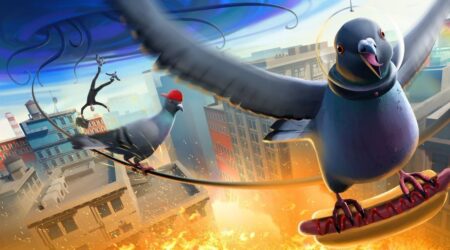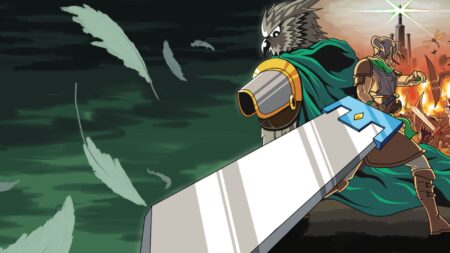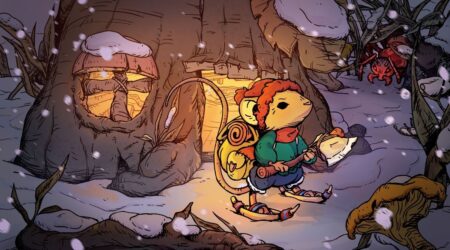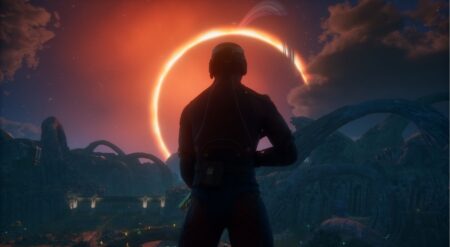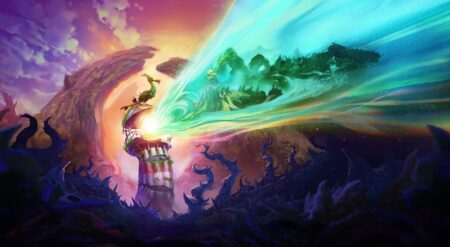Bandai Namco’s PAC-MAN, our yellow-shaped puck in a never-ending feud with ghosts over little, delicious balls, has been a staple of the gaming world since nearly the inception of gaming. Since its original release in 1980, we’ve helped this yellow guy survive mazes of all kinds, from its classic 2-D design to 3-D platformers. However, Bandai Namco has decided to take PAC-MAN in a new direction this year with its action-adventure, gritty Metroidvania, Shadow Labyrinth. And for the most part, the jump to a metroidvania works! It just doesn’t reach its full potential due to inconsistencies and refinement issues.
From a story perspective, Shadow Labyrinth does a lot with so little. Playing as Swordsman No. 8, you awaken on a mysterious planet, awoken by a floating yellow orb named Puck. Puck reveals to you that they are on a mission as part of the United Galaxy Space Force (UGSF) to stop a powerful AI from taking over anything it can reach. Yet failure after failure led to Puck being stranded on this planet for a long time. But something’s different about you. Maybe this eighth iteration will be the one to help Puck finish the mission once and for all.
What was surprising about going into Shadow Labyrinth was learning how interconnected many of Bandai Namco’s games are. Like, did you know that there is a full United Galaxy Space Force timeline? A timeline that interconnects its sci-fi-based properties? Neither did I. And Shadow Labyrinth finds itself fitting perfectly together into this universe. Even then, the story at its core feels pretty basic, and not in a bad way.
Dropping you head-first into something so expansive and full of stories that many people may not know about could be overwhelming. Yet the story in Shadow Labyrinth never tries to bog you down with all that information. It focuses mainly on Puck’s mission. But that’s not to say there isn’t a story. The one that is slowly revealed is full of mystery and intrigue. Like, why was this person chosen to be Swordsman No. 8? Who exactly is Puck, and why were they stranded? Why don’t each of the people you meet along your journey also help you stop this AI threat?
Shadow Labyrinth is full of references as it leans heavily on the interconnectedness of the UGSF timeline.

Many people you meet and enemies you face are based on those classic Bandai Namco properties. Like Bosconian being referenced as a group of people also trapped on this mysterious world. Or how Galaga spacecraft are types of enemies you face later on. Numerous people, friend and foe, have been drawn to this planet for some reason or another. And their evolution to fit in with the rest of Shadow Labyrinth’s atmosphere works well.
However, the gameplay doesn’t quite match the story yet… Shadow Labyrinth, at its core, is a basic 2-D metroidvania. Lots of branching pathways, clear indicators of things that should be revisited later with upgrades, and secrets galore that will award you with upgrades and lore bits. What sets it apart from the rest of the metroidvanias is its implementation of a sci-fi version of PAC-MAN.
The primary gameplay in Shadow Labyrinth involves fighting enemies. You get a sword early on that can hack through your foes, dodge around attacks, and destroy obstacles with it. You can also gobble up enemy corpses for key upgrade materials to be used at certain vendors. This changes a harrowing mission of survival into a hunt. The game thankfully makes it clear which enemies drop what and where they can be located.
Similarly, exploration in Shadow Labyrinth is crucial for surviving and conquering later challenges, such as those that require upgrades beyond vendor offerings. Health increases, increased healing orbs, and key materials to upgrade basic stamina and attack damage are hidden throughout this ever-expanding planet. Heck, even after reaching the final boss, there was still so much more to find. I spent a couple of extra hours before fighting the last boss to look around and ended up finding several more bosses, upgrades, and areas never explored while following the golden path.

A key part of exploration and gameplay is reminiscent of classic PAC-MAN, where players turn into a yellow ball to ride along glowing walls and gobble up orbs. Called D-line tracks, these are interspersed throughout the numerous areas and never overused. However, this is an aspect that can be difficult to control at times, even with tools that allow you to maintain this portion more freely (such as bringing up a guiding line to gain a better sense of where you’ll jump or even turning off the constant movement on the lines).
Numerous times, the guiding line always felt like a suggestion, one that Puck rarely followed. Jumps would go at angles that didn’t match where the guiding line said. Or Puck would refuse to go into spaces they should have gone into just fine after several attempts. It’s just that maybe this key part of the game needed more focus to make sure it felt great, particularly when a significant part of the game involves navigating mazes styled after classic PAC-MAN levels, which often felt like slogs due to poor controls.
Similarly, Shadow Labyrinth is shockingly difficult. This is to a degree that felt more over-inflated than challenging. And that may be because basic mechanics were often not as effective as advertised, or due to wonky hitboxes, for example, the parry.
This is a key part for surviving late-game bosses and foes. However, it was often inconsistent in its execution. When it does, it’s not the most satisfying experience. The foe is just stunned for a second, and you can do slightly more damage. However, so many times, repeating the same action in the same window, following the exact timing, either led to nothing happening or resulted in my taking damage. Similarly, the hitboxes are not well telegraphed enough for the sheer amount of damage being doled out later on in the game.
Exploration and gameplay can be frustrating to navigate at times in Shadow Labyrinth.

You could be standing in what looks like a safe space under the boss, and a pixel over in what still seems like a safe spot, you’d take a hit of damage for touching them. Attacks regularly appeared to be ineffective, but they often proved otherwise. Or the dodge i-frames, a window in dodging where you avoid all damage, would inconsistently cut out, leading to additional unnecessary damage.
And the sheer amount of damage being doled out is shockingly unfair later on. If a game uses a multi-segmented health-based system, like instead of a clear XX/XX hitpoints, you have four segments of health, where one hit takes away one segment, you’d expect that to be consistent damage. Maybe later on, you’d lose two or three segments for getting hit by big attacks.
But in mid-to-late-game fights, even normal foes will take away three, four, or five segments of health just for touching them. Paired up with the aggravating, inconsistent hitboxes, Shadow Labyrinth becomes more annoying with its over-inflated challenge. Many fights were won because of what felt like luck rather than skill.
This also applies to environmental challenges when exploring new areas. Sometimes, pixel-perfect accuracy is necessary to get through certain parts. And that pixel is also not always the same, even with repeated actions. One segment in particular comes to mind, with climbing a shaft of smashing compressors. You need to jump on one and jump again at the exact moment you land to get onto the next. So many times, just doing the same action would lead to a reset because I got smashed. Even though I was clearly safe in the image, I was also resetting progress at the same time.

But that’s not to say the fights and bosses aren’t fun in Shadow Labyrinth. With the sheer amount of bosses and mini-bosses, they are all impressively unique in execution and design. Each has its challenge and is like a puzzle to figure out quickly. Each one also has several phases that lead to progressively more challenging encounters as the fight progresses. The bosses are a major standout of the game, with some of my favorites even being “optional”.
To boil this all down, Shadow Labyrinth is a fun game. I had fun with it and look forward to playing more. However, it needs more work to iron out the kinks, refine the edges, and alleviate the frustration, creating an experience that is as fun as it is challenging.
Because challenge is fun, it’s just when it crosses the line to being unfair or expecting 99% perfect gameplay constantly from the player that the challenge becomes annoyance and frustration. With some updates to these issues and balancing, Shadow Labyrinth could easily become one of my favorite Metroidvanias. It’s just not there yet.
Especially with its gritty art style, which takes classic Bandai monsters and transforms them into nightmare fuel that also fits narratively, it feeds me. I loved playing classic Bandai arcade cabinets like those at the dentist’s office. Seeing how they’ve all evolved is really cool. Especially in well-designed environments that push you to want to explore everything, even with constant teasing of clearly observable collectibles that are out of reach, add up to so much right in a Metroidvania. Additionally, with regular views that leave you awestruck, even in a 2D environment, the art style itself is a major standout that deserves recognition. The rest of the game can be updated to match the art style’s level of quality.
With more refinement, Shadow Labyrinth could easily become a great modern-day Metroidvania.

Shadow Labyrinth is a great idea. I mean, what’s more maze-like than a Metroidvania? And its incorporation of other Bandai Namco classic properties into a universe that feels fleshed out and fits together excellently takes what could have been a mediocre idea and elevates it. It turns it into something extraordinary, like turning PAC-MAN into a gritty Metroidvania. It never feels like the property was added solely for brand recognition. Puck’s presence in the world feels natural and like a true evolution of the property for the modern era beyond a PAC-MAN Championship Edition.
However, poorly defined hitboxes, inconsistent mechanics, and over-inflated difficulty bog down what could have been a great experience. Even fighting harder end-game bosses leads you to walking away exhausted and unsatisfied. For now, Shadow Labyrinth is simply a fine adaptation of one of gaming’s legends.
Shadow Labyrinth is available on Nintendo Switch, Nintendo Switch 2, Xbox Series X|S, PlayStation 5, and PC on July 18th.
Shadow Labyrinth
-
Rating - 7/107/10
TL;DR
Shadow Labyrinth is a great idea. However, poorly defined hitboxes, inconsistent mechanics, and over-inflated difficulty bog down what could have been a great experience.



